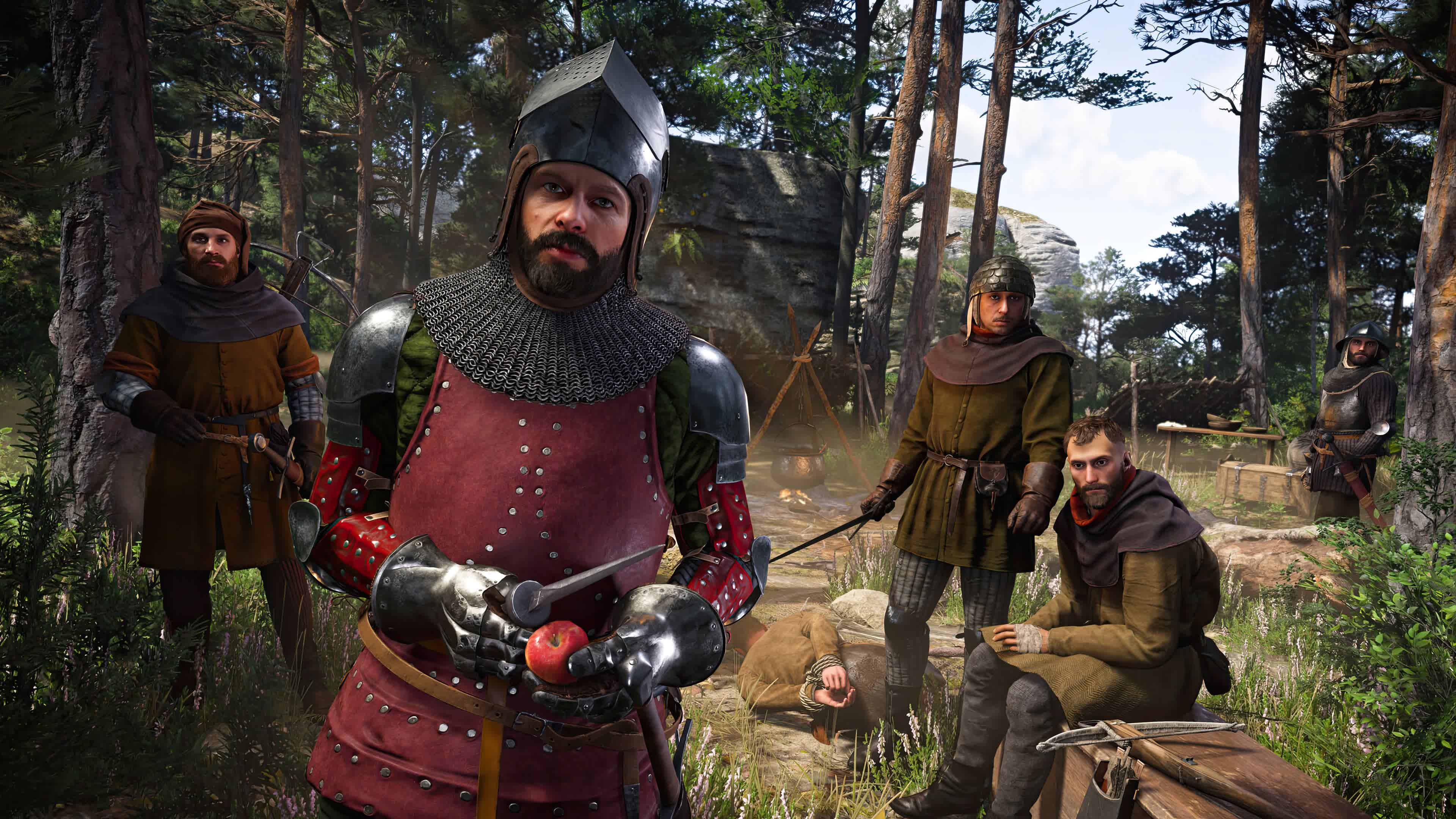www.techspot.com
In an age where flagship GPUs are said to cost $2,000 but, in reality, cost considerably more and that's assuming you can even find one we no longer feel excited for the latest and greatest games using cutting-edge rendering techniques. More often than not, these games are poorly optimized, and beyond that, they're usually not even fun to play.But, every now and then, we do get a new AAA title that doesn't run like hot garbage, doesn't require a flagship GPU for a smooth 60 fps (even with upscaling), and, above all else, is simply a good video game.But, every now and then, we do get a new AAA title that doesn't run like hot garbage, doesn't require a flagship GPU for a smooth 60 fps (even with upscaling), and, above all else, is simply a good video game. The most recent example of this rare phenomenon is Kingdom Come: Deliverance II, a game with a metascore of 88, equally positive user reviews, and very positive Steam reviews. So, we've got a good one here.With that in mind, we've spent the last few days doing nothing but benchmarking GPUs day and night to bring you the most comprehensive performance guide possible. We've tested 35 GPUs, across three resolutions, using four quality configurations. As usual, there's a lot of data to go over.But before we get into that, a few additional notes:First, Kingdom Come: Deliverance II is built on the aging CryEngine albeit a heavily customized version but this means that features like ray tracing aren't included. We really do wonder how many gamers actually care about that. There's also no frame generation, which, while not a bad feature by any means, has limited usefulness in many cases.Both DLSS and FSR upscaling are supported though, and they are genuinely useful technologies.Ultimately, this means Kingdom Come: Deliverance II isn't going to win any awards for best graphics not by a long shot even though some of its locales are quite impressive. But as the reviews indicate, this isn't important. Gamers are more than happy to forgo visual fidelity for a game that is both fun to play and runs well two things that often go hand in hand.Don't get me wrong though, the game looks perfectly fine, and some aspects are even impressive, but overall it's not on the same level as something like Cyberpunk 2077, for example.For testing, we're using an early-game section appropriately titled Quest Start, where you ride on horseback along a predefined path. This setup makes for a highly repeatable graphical benchmark. Each test run lasts for 60 seconds, after which we can quickly reload to the starting point and run it again.We're testing at the standard 1080p, 1440p, and 4K resolutions, using the Medium, High, and Ultra presets, along with an Ultra + Upscaling configuration, using 'DLSS Quality' for the GPUs that support it and 'FSR Quality' for everything else.We've skipped the 'Low' preset because, while it looks fine, the jump to 'Medium' is a significant visual upgrade. In fact, moving from Medium all the way to Ultra often isn't a drastic improvement, though it does reduce pop-in, which can be an issue in this game.There's a lot of data to go over so let's get into itBenchmarksUltra 1080pStarting with the native 1080p Ultra data, we see several promising signs. First, it's possible to achieve very high frame rates in this title, so flagship GPUs won't be capped at just over 100 fps something we've seen far too often recently. That, of course, spells disaster for mid-range and entry-level products.For around 90 fps which we generally aim for as a baseline the RTX 3080 or 4070 are more than sufficient. However, on the AMD side, you'll need a Radeon RX 7900 XT, as the 7900 GRE falls a bit short. It appears that, at least for now, Nvidia has an advantage over AMD in this title, as GPUs like the 7700 XT trail just behind the RTX 4060 Ti, which isn't typical.For 60 fps or better, the Arc B580 performs well, along with the RX 6800 and RTX 3060 Ti. It's good to see these older models still delivering a solid experience at the Ultra quality preset.Ultra 1440pJumping up to 1440p, you'll want a 6900 XT, 7800 XT, 7900 GRE, or RTX 4070 for over 60 fps. Nvidia still maintains a performance advantage at this resolution, with the 7900 XTX only managing to match the RTX 4070 Ti at 90 fps. For over 100 fps, you'll need an RTX 4080, 4080 Super, 5080, 4090, or 5090. As expected, the RTX 5080 was 11% faster than the 4080 Super and 13% slower than the 4090.Ultra 4KAt native 4K, you'll need an RTX 4080 or 4080 Super for 60 fps. The RTX 5080 offers an additional 16% performance boost, reaching 73 fps on average in our test. The 4090 was another 18% faster, while the 5090 was 35% faster than the 4090.Ultra (Upscaling) 1080pNow enabling upscaling at 1080p something we don't typically recommend since the render resolution is too low, even with the quality upscaling option DLSS generally performs better than FSR. With upscaling enabled, the RTX 5080 became 17% faster, while lower-end models like the RTX 4060 saw a 28% performance boost. On the Radeon side, the 7900 XTX gained 11% with FSR enabled, while the RX 7600 saw an 18% uplift. The good news is that nearly all tested GPUs were now capable of rendering 60 fps.Ultra (Upscaling) 1440pMoving up to 1440p, the RX 6800 now reaches 60 fps thanks to a 22% performance boost from FSR Quality upscaling. Several reasonably affordable GPUs, such as the 7700 XT and RTX 4060 Ti, now exceed 70 fps.Ultra (Upscaling) 4KAt 4K, we see the true benefits of upscaling. High-end GPUs such as the RTX 5090 saw a 33% performance uplift, with the same improvement observed on the 7900 XTX, allowing it to average 73 fps the same level of performance as the RTX 4070 Ti. Meanwhile, the 7900 XT and RTX 3080 now reach 60 fps.High 1080pDropping down to the High preset boosts the RTX 5090's performance by a massive 50%, reaching 341 fps. This is excellent news because it means that nearly all GPUs can now render over 60 fps at native 1080p. Even the RTX 3060 Ti is now capable of nearly 100 fps on average.High 1440pAt 1440p, the Radeon RX 7900 XTX sees an almost 40% performance increase compared to Ultra settings, while the RTX 4070 Ti gains 32%. This means playing at over 60 fps with the High preset, even at 1440p, is easily achievable with an Intel Arc A770, B580, RTX 3060 Ti, or RX 6800.High 4KAt 4K, we observe a 28% performance increase for the RTX 5090 compared to Ultra, with a 31% improvement for the 7900 XTX. For 60 fps or better, you'll need an RTX 4070 Ti or 7900 XT though the Radeon GPU just barely falls short of that target.Medium 1080pSwitching to the Medium preset at 1080p further boosts the RTX 5090's performance by 9% over High and an impressive 64% over Ultra. Meanwhile, the RTX 4070 enjoys a 21% uplift from High to Medium, marking a 69% increase from Ultra to Medium.This means that all GPUs can now render over 60 fps even the lower-end Radeon RX 6600 while still maintaining great visual quality.Medium 1440pAt 1440p (native), using the Medium preset, the RTX 3060, RX 7600, and RX 7600 XT achieve an average of 59 fps, while the RTX 4060 hits 63 fps and the Arc B580 reaches an impressive 77 fps. For those targeting 90 fps or better, the RX 6800 XT, 7700 XT, 7800 XT, or RTX 4070 will do the job.Medium 4KFinally, at native 4K using the Medium preset, achieving over 60 fps is possible with an RTX 3080, 4070 Super, or 7900 XT. Meanwhile, for over 90 fps, the RTX 4080, 4080 Super, 5080, 4090, or 5090 will work well.Kingdom Come FTW!Testing Kingdom Come: Deliverance II was a breath of fresh air. As a wise man once said, "It Just Works." It's rare these days that we play or even test a game using CryEngine. Hunt: Showdown might be the only current example.Seriously though, it was refreshing to test a game that loads quickly and doesn't have shader compilation screens that take several minutes in fact, it doesn't have them at all. Levels load quickly, quality settings can be adjusted on the fly, and at least in our experience, the game never crashes. It's also well optimized, runs smoothly on a wide range of hardware, and won't trick your CPU into thinking it's running a Blender simulation.Just loading some modern games for testing feels like a mission in itself, as if successfully getting into the game is part of the challenge. Kingdom Come: Deliverance II is the opposite of that.Just loading some modern games for testing feels like a mission in itself, as if successfully getting into the game is part of the challenge. Kingdom Come: Deliverance II, on the other hand, takes just 27 seconds to launch from the moment you hit "Play" in Steam or only 18 seconds if you skip the splash screens.Loading into the level takes just 26 seconds, meaning you can go from the Windows desktop to actually playing in under a minute. While some of this depends on CPU and storage performance, believe us, there are countless modern games that take literal minutes before you can even start playing.Not only are shader compilation loading screens nonexistent, but traversal stutter is also completely absent. The game is smooth as silk. This really highlights the issues we've been facing with Unreal Engine games clearly, Epic needs to rethink a few things.On that note, a big part of Kingdom Come: Deliverance II's success likely comes down to the fact that it's built on an older but highly efficient game engine. The fact that the game still looks great using the Medium preset, and can deliver well over 60 fps at native 1440p with a GPU such as the Arc A770, RTX 3060 Ti, or RX 6700 XT, is fantastic. It means nearly everyone can enjoy this game without having to spend oodles of cash just to get a console-like experience.Forcing ray tracing would have been disastrous for these GPUs we've seen plenty of examples of that. Take Star Wars Outlaws, for instance. We're not even sure to what extent it uses RT effects at the Medium preset, but to achieve frame rates remotely comparable to Kingdom Come: Deliverance II, you need to enable upscaling.Now, Star Wars Outlaws might look better than Kingdom Come: Deliverance II at the Medium preset that's subjective. The point is, if RT effects were mandatory in Kingdom Come: Deliverance II rather than optional, the game likely wouldn't have been received as well as it has.Don't miss: The Most Anticipated PC Games of 2025 (Kingdom Come: Deliverance II is one of them)Some might argue that the game could look much better with RT lighting, but if we consider most examples, the odds of that being the case aren't great. What we do know for sure is that RT would significantly reduce performance, likely for only a minor visual upgrade or one that most gamers wouldn't find worth the performance hit. We don't think we're wrong about this, and we'd bet most of you agree. Let us know in the comments below.That said, optional RT effects are fine as long as implementing them doesn't take away time that could otherwise be spent optimizing the game. As a side note, Kingdom Come: Deliverance II does offer a preset above "Ultra," labeled "Experimental," but we didn't bother benchmarking it. The visual quality difference was negligible, making the performance hit seem unnecessary.Another area where Kingdom Come: Deliverance II doesn't push visual boundaries is textures, though overall, they're certainly good enough. Even on the Ultra preset, gaming on an 8GB graphics card isn't an issue. The 8GB and 16GB versions of the RTX 4060 Ti delivered identical performance throughout our testing. That said, allocating a bit more VRAM to reduce pop-in would have been a welcome improvement.Overall, it's great to see so many gamers enjoying Kingdom Come: Deliverance II (one of our Most Anticipated PC Games of 2025), and from a performance perspective, we can see why. Hopefully, we'll see more well-optimized titles in 2025 though we certainly won't hold our breath.Shopping Shortcuts:Nvidia GeForce RTX 5080 on AmazonNvidia GeForce RTX 5090 on AmazonAMD Radeon RX 7900 XTX on AmazonNvidia GeForce RTX 4070 Super on AmazonIntel Arc B580 on AmazonAMD Radeon RX 7600 on AmazonAMD Radeon RX 7800 XT on AmazonAMD Radeon RX 7900 XT on Amazon











